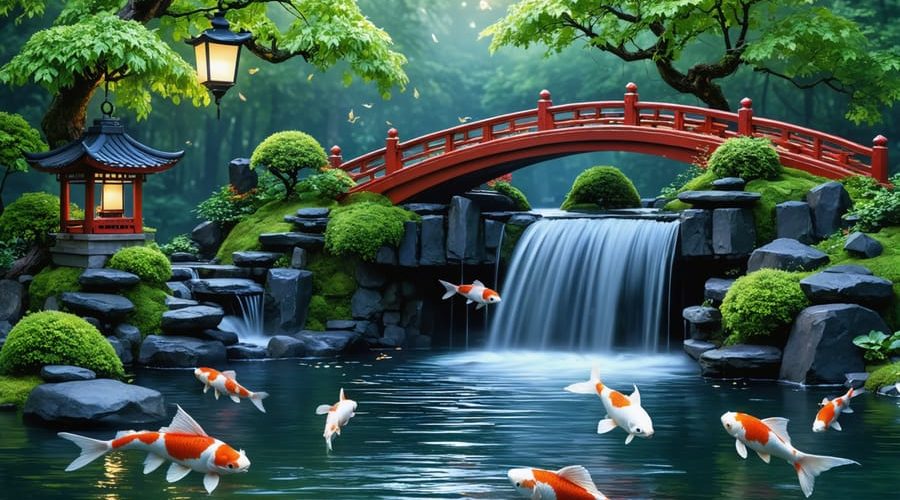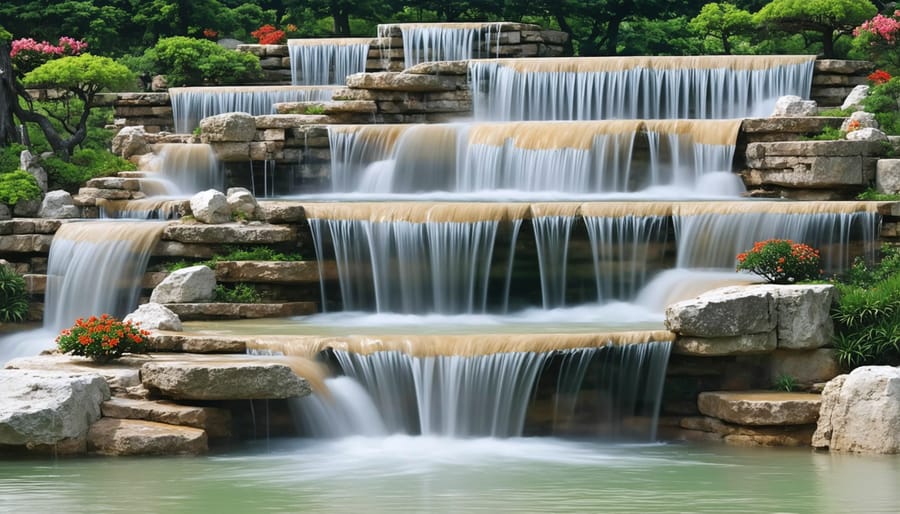
Sacred Waters: How Japanese Mythology Transforms Modern Garden Ponds
Transform your outdoor space into a mesmerizing Japanese sanctuary by embracing the ancient sacred water traditions that have shaped these mystical gardens for centuries. Layer dramatic stone arrangements with delicate maples and flowing water features to create the signature asymmetrical balance that defines Japanese garden design. Position moss-covered lanterns and curved bridges strategically to guide visitors through intentionally framed views, each revealing a new perspective of your garden’s story. Let the gentle sound of bamboo water features and carefully placed koi ponds transport you to a place of deep tranquility, where every element serves both practical and spiritual purposes.
The art of Japanese gardening transcends mere decoration – it’s a philosophical practice that mirrors nature’s perfect imperfection. These gardens have captivated visitors for generations, combining minimalist design principles with profound symbolic meaning to create spaces that feel both grounding and transcendent. Whether you’re working with a sprawling landscape or a modest courtyard, Japanese garden elements can transform any outdoor space into a contemplative haven that honors both tradition and innovation.
The Dragon Kings’ Realm
Dragon-Scale Cascades
Dragon-scale cascades bring an enchanting touch of Japanese mythology to your garden, creating a waterfall that seems to flow across the back of a sleeping dragon. This unique design uses overlapping stone plates arranged in a pattern that mimics dragon scales, with water trickling down in mesmerizing patterns.
To create this effect, start by selecting flat stones of varying sizes, preferably with natural texture and weathered edges. Arrange them in a descending pattern, slightly overlapping each stone like fish scales or roof tiles. The key is to position them at angles between 30 to 45 degrees, allowing water to dance and play across their surfaces.
For authentic Japanese style, choose dark-colored stones like slate or basalt, which create beautiful contrasts when wet. Space the stones slightly apart to create multiple tiny waterfalls, producing that signature gentle tinkling sound that Japanese gardens are famous for.
Consider adding moss between the stones to soften edges and create an aged look. LED lighting placed strategically behind the cascade can create dramatic evening effects, making the water shimmer like moonlight on dragon scales. Remember to keep the overall design asymmetrical and natural-looking, avoiding perfectly straight lines or uniform patterns.

Palace-Inspired Pool Designs
Japanese mythology tells of enchanting underwater dragon palaces called Ryūgū-jō, which have inspired some of the most captivating historical pool designs. You can bring this mysterious underwater world to life in your garden by creating deep, shadowy pools with strategically placed elements.
Start with a deeper-than-average pond, ideally around 4-5 feet, to create that sense of mystery. Dark pool liners work best, as they give the water a mirror-like quality and create the illusion of infinite depth. Position large rocks and boulders along the edges, allowing some to jut out over the water’s surface.
Add dragon-inspired elements subtly – think curved stone pathways leading to the pool, or dragon-scale patterns in your paving. Traditional Japanese water plants like lotus and water iris help create layers of depth, while koi fish add living movement and flashes of color beneath the surface.
Install underwater lighting with a blue-green tint to create an otherworldly glow at night. Position small waterfalls or cascades to create gentle ripples that catch the light. Remember to include comfortable seating areas where you can sit and imagine the mysterious palace that might lie beneath those dark waters.
Koi: The Living Legends
Sacred Fish Selection
Selecting koi for your Japanese garden goes beyond just picking pretty fish – each variety carries deep mythological significance. The classic Kohaku, with its white body and red markings, represents perseverance and good fortune. These living jewels are believed to embody the spirit of samurai warriors, bringing strength and protection to your garden.
Consider adding the Showa variety, featuring black, red, and white coloring, which symbolizes life’s balance and transformation. The metallic-scaled Ogon koi, gleaming like gold or platinum, are thought to attract prosperity and abundance to their keepers.
For those seeking wisdom and spiritual growth, the dragon-like Asagi koi, with their net-like blue scaling, make perfect additions. The peaceful Bekko variety, displaying black spots on white, red, or yellow bodies, represents tranquility and meditation.
Choose an odd number of koi, as this is considered lucky in Japanese culture. Three to five fish create an ideal balance for smaller ponds while allowing each fish’s unique patterns and meanings to shine through. Remember, these sacred swimmers aren’t just pets – they’re living symbols of ancient Japanese mythology swimming in your garden.
Creating Legendary Habitats
In Japanese culture, koi are more than just ornamental fish – they’re living symbols of perseverance and transformation. Creating a habitat worthy of these legendary creatures requires thoughtful design that blends functionality with spiritual significance. Start by designing varying depths in your pond, with deeper areas of at least 4-5 feet where koi can retreat during extreme weather. Incorporate smooth stones and overhanging plants along the edges to mimic their natural environment and provide shelter.
Traditional Japanese gardens often feature curved bridges over koi ponds, representing the path between earthly and spiritual realms. Consider adding a small wooden bridge or stepping stones to create this symbolic crossing. Include meditation spots around the pond where you can observe these magnificent creatures – perhaps a bamboo bench or flat stones for seating.
Don’t forget to add underwater caves and hiding spots using large rocks or ceramic structures. These elements not only protect your koi but also create the mysterious atmosphere associated with Japanese mythology. Complete the habitat with carefully chosen water plants like lotus and water lilies, which add both practical benefits and cultural significance to your pond design.
Bridge to the Spirit World
Sacred Crossing Designs
In Japanese gardens, bridges are more than just functional crossings – they’re sacred pathways that connect the earthly realm with the spiritual world. The graceful arch of a moon bridge (taiko-bashi) represents the journey between earth and heaven, while its reflection in the water creates a perfect circle symbolizing wholeness and enlightenment.
Red lacquered bridges are particularly significant, believed to ward off evil spirits and represent the path to paradise. These vibrant crossings often appear in Zen gardens, creating striking contrast against dark water and green foliage. For a more natural look, simple wooden plank bridges (yatsuhashi) zigzag through iris beds, encouraging visitors to slow down and appreciate each step of their garden journey.
Stone bridges, made from flat natural rocks, symbolize stability and permanence. These understated crossings are often used in tea gardens, where their rustic appearance complements the meditation path. For smaller spaces, stepping stones arranged in gentle curves create the essence of a bridge while maintaining an open feel.
Whatever style you choose, position your bridge where it frames an important view or creates an inviting pathway to a garden focal point.

Placement for Spiritual Flow
In Japanese garden design, the placement of bridges isn’t just about crossing water – it’s about creating a spiritual journey. These pathways serve as transitions between different energetic spaces, much like how water symbolism in gardens connects the physical and spiritual realms.
When positioning your bridge, consider placing it where the water’s flow is most visible or audible. This creates a natural pause point, encouraging visitors to stop and reflect. Traditional wisdom suggests placing bridges at slight angles rather than straight across – this subtle shift helps break negative energy and creates a more contemplative experience.
The height of your bridge also matters. Lower bridges keep you close to the water’s energy, while higher arched bridges create a sense of ascending to a different spiritual plane. For maximum impact, position your bridge where it frames a special view or garden feature, like a stone lantern or carefully pruned maple tree.
Remember to leave some open space around the bridge approaches – this “breathing room” allows spiritual energy to flow freely and creates a more harmonious transition between garden spaces.

Plants of the Gods
Sacred Lotus Selection
The sacred lotus holds a special place in Japanese garden design, symbolizing enlightenment, purity, and spiritual awakening. When selecting lotus plants for your garden pond, consider both their symbolic meaning and practical growing requirements.
White lotus varieties, like the ‘White Crane,’ represent absolute purity and are perfect for meditation gardens. Place these in open areas where sunlight can illuminate their pristine petals. Pink lotus flowers, such as the ‘Red Paradise,’ symbolize the heart of Buddha and work beautifully as centerpiece plantings.
For smaller ponds, consider dwarf varieties like the ‘Mini Snow White’ or ‘Baby Pink.’ These compact plants carry the same spiritual significance while fitting perfectly in limited spaces. Position your lotus plants in the eastern or southern part of your pond, as these directions are traditionally associated with enlightenment in Japanese culture.
Layer your lotus selection by height to create visual depth. Tall varieties can reach up to 6 feet, making dramatic statements when placed at the back of the pond. Medium-height varieties work well in the middle ground, while smaller specimens can grace the edges.
Remember that lotus plants need at least 6 hours of direct sunlight and prefer still water. Plant them in containers filled with heavy garden soil, topped with gravel to prevent soil dispersion. This traditional planting method ensures your sacred lotus will thrive while maintaining its profound symbolic presence in your Japanese garden.
Divine Iris Gardens
In Japanese garden design, iris flowers hold a special place, deeply connected to ancient deities and mythology. The most revered variety is the Japanese iris (Iris ensata), believed to be a favorite of Izanami, the goddess of creation. These stunning purple blooms traditionally line water features and pond edges, creating a mystical atmosphere that honors their divine associations.
To create your own divine iris garden, start by selecting a mix of Japanese iris varieties. The deep purple ‘Imperial Magic’ represents wisdom, while the white ‘Sugar Dome’ symbolizes purity – qualities associated with the Shinto goddess Konohana Sakuya. Plant these beauties in groups of three or five along the water’s edge, as odd numbers are considered auspicious in Japanese design.
For authentic impact, incorporate the yellow flag iris, linked to Benzaiten, the goddess of everything that flows. These water-loving plants thrive in boggy conditions and create stunning reflections in pond water. Consider adding the butterfly iris, connected to Amaterasu, the sun goddess, which attracts pollinators and adds height to your garden.
Remember to maintain proper spacing between iris clusters to allow for natural growth patterns. Japanese gardeners traditionally plant irises where they can be viewed from a meditation spot or tea house, believing their divine connections enhance spiritual contemplation. Add stepping stones nearby to create easy viewing access, and consider placing a small stone lantern among the irises to honor their celestial connections.
Modern Interpretation Tips
Creating a modern Japanese garden doesn’t mean abandoning traditional elements – it’s about finding the perfect balance between ancient wisdom and contemporary style. Start by selecting clean-lined versions of classical features: choose geometric stone lanterns over ornate ones, or opt for simplified bamboo fencing rather than elaborate wooden structures.
For water features, consider incorporating a sleek reflection pool instead of a traditional koi pond. You can still maintain the spiritual significance while updating the aesthetic. Modern materials like polished concrete or brushed steel can complement natural elements, creating an interesting contrast that speaks to both modern garden spirituality and contemporary design.
When it comes to mythological elements, focus on subtle representations. Instead of traditional dragon sculptures, consider abstract water spouts or minimalist wave patterns in paving. Replace elaborate phoenix motifs with simple geometric designs that hint at wings or movement. Use lighting strategically to create mysterious shadows that suggest mythical creatures rather than displaying them literally.
Plant selection can also bridge the traditional-modern gap. While keeping Japanese maples and moss gardens, arrange them in bold, geometric patterns. Consider using native plants that mirror the function of traditional Japanese species but suit your local climate better.
Remember that less is more in modern Japanese garden design. Rather than filling every space, create purposeful voids that allow the eye to rest and the mind to contemplate. This approach honors the contemplative nature of traditional Japanese gardens while appealing to contemporary sensibilities.
As we’ve explored the enchanting world of Japanese garden mythology, it’s clear that these sacred spaces offer more than just visual beauty – they’re gateways to centuries of cultural wisdom and spiritual connection. By incorporating mythological elements into your water garden, you’re not just creating a peaceful retreat; you’re weaving ancient stories and symbolism into your everyday landscape.
Remember that even small touches can make a significant impact. Whether you choose to add a dragon fountain that represents strength and protection, or place a few carefully selected koi fish that symbolize perseverance and good fortune, each element adds layers of meaning to your garden. The gentle sound of flowing water, the strategic placement of stones, and the careful selection of plants all work together to create your own piece of Japanese mythology at home.
Don’t feel pressured to include every mythological element we’ve discussed. Start with what resonates most with you – perhaps a simple stone lantern to honor the light kami, or a bamboo water feature that pays tribute to water spirits. As your garden grows and evolves, so too can your incorporation of mythological elements.
The beauty of Japanese garden design lies in its ability to tell stories through landscape. By bringing these ancient myths and symbols into your garden, you’re not just creating a beautiful space – you’re becoming part of a living tradition that spans generations. Let your imagination guide you as you transform your outdoor space into a mythological haven that brings joy and meaning to every visit.
